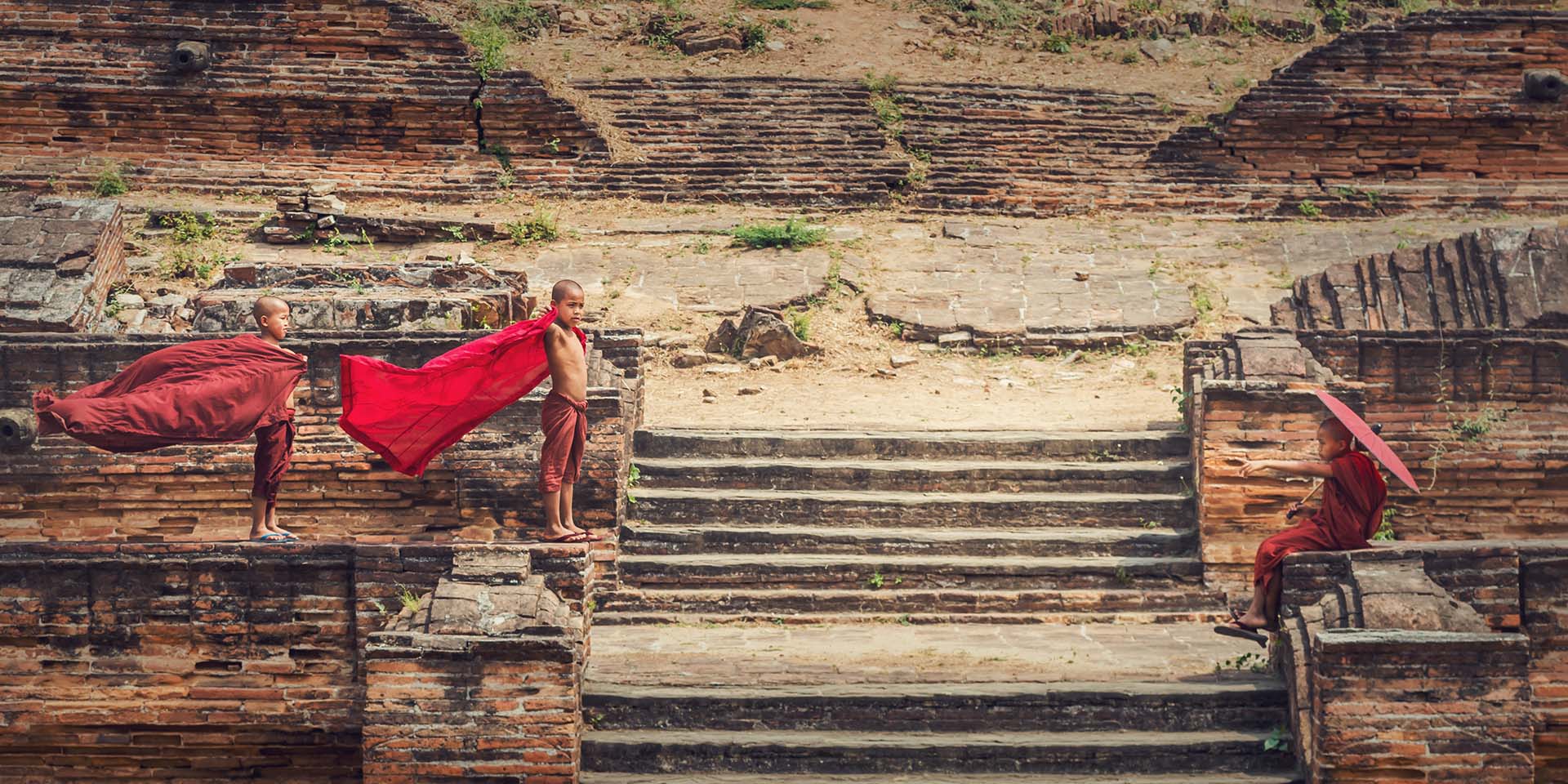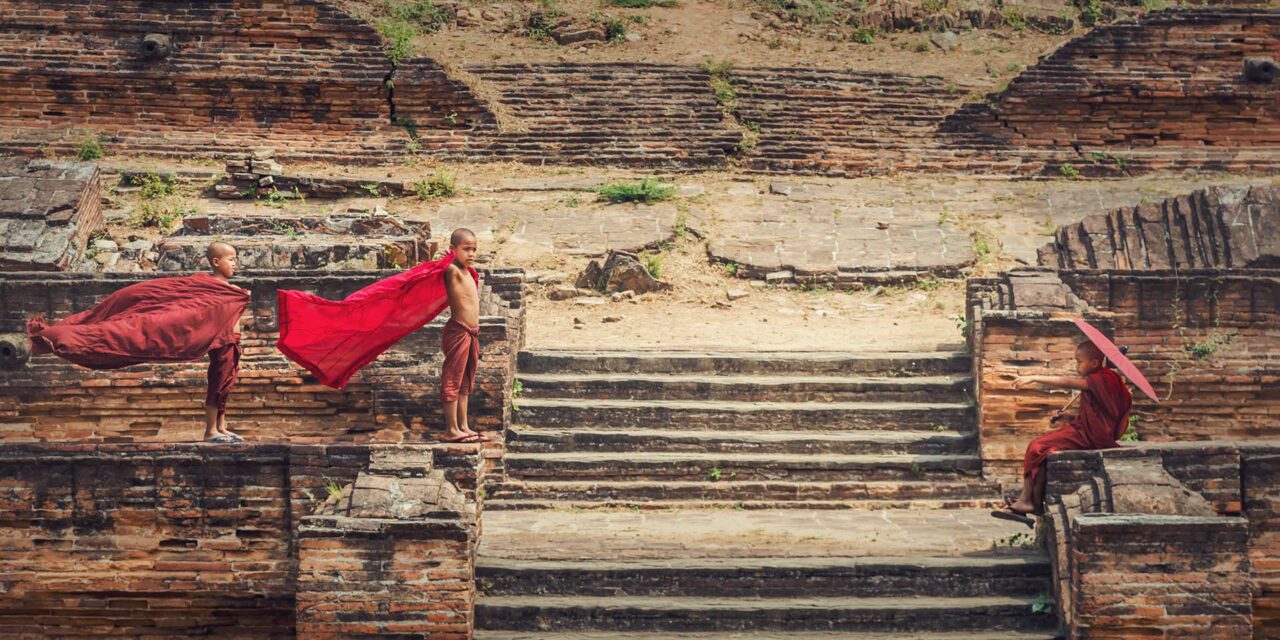Myanmar is newly-opened to the tourist masses who are flocking to Burma for diving, beaching, and exploring in the islands of the Andaman Sea and the Mergui Archipelago. There are those, however, who argue that the heart of Myanmar is inland, where the cultures are stark and the landscape starker.
Passing some of the most untouched areas of Southeast Asia, travelers can peek into gem markets, fishing baskets, and river boats for a path to Myanmar’s deep, abiding traditions. Yes, further inland is where modern Myanmar’s problems are at their worst, but it’s also where the culture shines brightest.
Colonial History in Pyin Oo Lwin

ABOVE: A Victorian horse-drawn carriage in Pyin Oo Lwin among rickshaws and temples.
Logistics dictate that the Myanmar traveler in the north will probably arrive via Mandalay international airport. That’s a pretty short road to Mandalay, and one can certainly disembark to see the sights. But, as anyone will tell you, it’s much more rewarding after one has journeyed the highlands and the Irrawaddy.
To begin, drive two hours east of Mandalay to a former British military post in the Shan Highland. Pyin Oo Lwin is a delightful town in the hills, and, say what one will, it is unique. Remnants of the British colonial era exist today in the curious features that abound throughout the area – from manicured gardens and architecture to horse-drawn carriages.
The intriguing mix of Old World remnants and local culture, surrounded by the green grass of the highlands, makes for a singularly odd but inviting experience. Visitors can explore other former British stations or several stunning cascading waterfalls in the area. One of the major attractions is the train to Hsipaw, which runs over the Goteik viaduct, the highest railway bridge in the world.

ABOVE: Goteik viaduct in Myanmar’s highlands is the highest railway bridge in the world.
The area here is populated by the Shan people, an ethnic group of Theravada Buddhists with a fascinating history in the region. The Shan are believed to have migrated from China from as far back as the 10th century. Their daily life is much the same as it always has been in the highlands; the majority live in small, rural villages, living off the land they farm and crafts of silver and bamboo.
The Valley of Rubies

ABOVE: Mogok is famous for its rubies and sapphires, but travelers are warned that the trade in them can be pretty cutthroat. Know your gems before you buy.
There are many great stops here in the highlands, but for those who like their souvenirs to shine, it’s a good time to head to Mogok. Famous for its mining, some of the highest quality precious and semi-precious gemstones available are available in Mogok.
The area is often referred to as the “valley of the rubies” as 90 percent of the world’s rubies are to be found in this magical region, which is also famed for its sapphires. Travelers are warned, however, to do a little research into gems. Garnets can be passed off for rubies and all manner of shakedown is possible when buying gems.
There is, however, more to Mogok than rubies. One can revel in the breathtaking panoramic views behind the stupas of Padamya Pagoda, high above the city. And, there’s more mining knowledge to be had in Kyat Pin, where visitors can learn about traditional techniques, interact with the miners, and maybe get a glimpse of the gem in its raw form as it’s plucked from the dirt.
Dolphins on the Watery Road to Mandalay

ABOVE: In the shadow of Burmese temples, a passenger ship idles in the waters of the Irrawaddy River.
The journey to Mandalay turns into a wet one, when one boards a cruise on the Irrawaddy River.
The Irrawaddy flows from north to south, cutting through the landscape before emptying into the Irrawaddy Delta. Used for trade and transport since the 6th century, it’s the country’s largest river and commercial waterway. The seasons can be tricky for this cruise, due to the levels in the rainy and monsoon season, so speak to an expert.
If you are the luckiest of people, you may get a chance to see the Irrawaddy dolphin, a freshwater dolphin more endangered each day. If there were such a thing as being scientifically adorable, it would be the Irrawaddy dolphin: Beluga-like heads, chubby necks, and big, goofy grins.

ABOVE: The Irrawaddy dolphin is critically endangered in the eponymous river, so chances of spotting it in the wild are slim.
The dolphins were once said to aid the fishermen with their catch, and at Ngwe Nyein village they still do, but unfortunately, this cute little creature is all but extinct in the eponymous river, due in no small part to fishing nets. A chance to spot the Irrawaddy dolphin – listed as critically endangered – would be the picture of a lifetime. Sadly, your odds of spotting them in the wild are close to none – but sometimes magic happens on the Road to Mandalay.
End of the Road to Mandalay

ABOVE: The famous U Bein Bridge over Taungthaman Lake just south of Mandalay, found in the former capital of Amarapura.
There are sights to see aplenty along this ancient river way. On the west bank, sits the sleepy town of Kyaukmyaung, known for its pottery and ceramic trade, crafted from clay pulled up from the riverbed. Further along, the traditional fishing village of Sein Pan Kon offers insight into life on the water’s edge.
And then, as it was always going to do, your wet road comes to an end in Mandalay.
Still though, there is more to see in this wonderland of Myanmar culture, some might say the best yet: the Mingun Pahtodawgyi. As legend has it, an astrologer once foretold that if the monument was completed, the King would die. Thus, the King ordered construction to cease, leaving it unfinished forever more.

ABOVE: Monks with umbrellas walk toward Mingun Pahtodawgyi, an unfinished temple from the 18th century just outside Mandalay.
Found just 10 kilometers from Mandalay, the project began in 1790 – a stark contrast to the white, ornate temples you would have seen along the way. The Mingun Pahtodawgyi is imposing – almost chilling. There is a rare quality among the larger temples in Asia: they make you feel terrifyingly small.
And there the temple stands, a fitting end to an all-too short road. There’s a world of culture to be explored in Mandalay alone, and having come from the highland mountains, Myanmar can seem so big and so, so hard to leave. But, as it’s practically required reading for this sort of trip, it’s like the man says:
Come you back to Mandalay,
Where the old Flotilla lay:
Can’t you ‘ear their paddles chunkin’ from Rangoon to Mandalay?
On the road to Mandalay,
Where the flyin’ fishes play,
An’ the dawn comes up like thunder outer China ‘crost the Bay!



